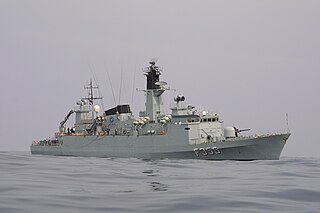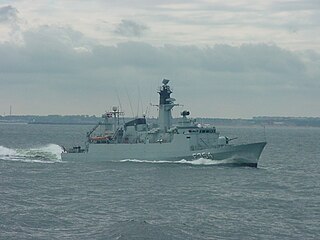
The Royal Danish Navy is the sea-based branch of the Danish Armed Forces force. The RDN is mainly responsible for maritime defence and maintaining the sovereignty of Danish territorial waters. Other tasks include surveillance, search and rescue, icebreaking, oil spill recovery and prevention as well as contributions to international tasks and forces.

Peter Jansen Wessel Tordenskiold, commonly referred to as Tordenskjold, was a Norwegian nobleman and flag officer who spent his career in the service of the Royal Dano-Norwegian Navy. He rose to the rank of vice-admiral for his services in the Great Northern War. Born in the Norwegian city of Trondheim, Peter Wessel travelled to Copenhagen in 1704 and eventually enlisted in the navy.

The Battle of Heligoland was fought on 9 May 1864, during the Second Schleswig War, between a Danish squadron led by Commodore Edouard Suenson and a joint Austro-Prussian squadron commanded by the Austrian Commodore Wilhelm von Tegetthoff. The action came about as a result of the Danish blockade of German ports in the North Sea; the Austrians had sent two steam frigates, SMS Schwarzenberg and Radetzky, to reinforce the small Prussian Navy to help break the blockade. After arriving in the North Sea, Tegetthoff joined a Prussian aviso and a pair of gunboats. To oppose him, Suenson had available the steam frigates Niels Juel and Jylland and the corvette Hejmdal.

The Battle of Öland was a naval battle between an allied Danish-Dutch fleet and the Swedish navy in the Baltic Sea, off the east coast of Öland on 1 June 1676. The battle was a part of the Scanian War (1675–79) fought for supremacy over the southern Baltic. Sweden was in urgent need of reinforcements for its north German possessions; Denmark sought to ferry an army to Scania in southern Sweden to open a front on Swedish soil.

The Battle of Møn, also known as the Battle of Fehmarn, took place 31 May–1 June 1677, as part of the Scanian War. A smaller Swedish squadron under Admiral Erik Sjöblad attempted to sail from Gothenburg to join the main Swedish fleet in the Baltic Sea. It was intercepted by a superior Danish-Norwegian force under Niels Juel and decimated over the course of two days. The Swedes lost 8 ships and over 1,500 men dead, injured or captured, including Admiral Sjöblad himself, while the Danish losses were insignificant.

Niels Juel was a Danish admiral and naval hero. He served as supreme command of the Dano-Norwegian Navy during the late 17th century and oversaw development of the Danish-Norwegian Navy.

Kronan, also called Stora Kronan, was a Swedish warship that served as the flagship of the Swedish Navy in the Baltic Sea in the 1670s. When built, she was one of the largest seagoing vessels in the world. The construction of Kronan lasted from 1668 to 1672 and was delayed by difficulties with financing and conflicts between the shipwright Francis Sheldon and the Swedish admiralty. After four years of service, the ship foundered in rough weather at the Battle of Öland on 1 June 1676: while making a sharp turn under too much sail she capsized, and the gunpowder magazine ignited and blew off most of the bow. Kronan sank quickly, taking about 800 men and more than 100 guns with her, along with valuable military equipment, weapons, personal items, and large quantities of silver and gold coins.

The history of the Danish navy began with the founding of a joint Dano-Norwegian navy on 10 August 1510, when King John appointed his vassal Henrik Krummedige to become "chief captain and head of all our captains, men and servants whom we now have appointed and ordered to be at sea".

The Battle of Køge Bay was a naval battle between Denmark-Norway and Sweden that took place in the bay off of Køge 1–2 July 1677 during the Scanian War. The battle was a major success for Admiral Niels Juel and is regarded as the greatest naval victory in Danish naval history.

HDMS Olfert Fischer (F355) was a Niels Juel-class corvette of the Kongelige Danske Marine. The vessel was laid down in December 1978 and commissioned in October 1981. The corvette operated in the Persian Gulf on two occasions, first in 1990 and 1991 as part of the multinational fleet enforcing the United Nations sanctions against Iraq, then again in 2003 in support of the United States-led invasion of Iraq. Olfert Fischer was deployed as part of the NATO Standing Naval Force Atlantic on at least four occasions during her career.

The battle of Bornholm was a naval battle between a superior Swedish and a smaller Danish-Dutch fleet that was fought 25–26 May 1676 as a part of the Scanian War. The objective for both sides was naval supremacy in the southern Baltic Sea. The Swedish commander Lorentz Creutz sought to destroy the allied fleet and then land reinforcements in Swedish Pomerania to relieve the Swedish forces in northern Germany. The aim of the Danish fleet under Niels Juel was to prevent this reinforcement without being destroyed by the superior numbers of the Swedish forces.

Claes Johansson Uggla was a Swedish military officer of the 17th century, who served in both the army and the navy, reaching the rank of admiral before he was killed in action during the naval Battle of Öland.
Four ships of the Danish Royal Navy have borne the name HDMS Niels Juel:

HDMS Niels Juel was a training ship built for the Royal Danish Navy between 1914 and 1923. Originally designed before World War I as a monitor, construction was slowed by the war and she was redesigned as a training cruiser. Completed in 1923 she made training cruises to the Black and Mediterranean Seas, South America and numerous shorter visits to ports in northern Europe. The ship often served as a flagship and occasionally was used as a royal yacht for visits to overseas possessions and other countries.

The Battle of Isefjord was a clash that occurred when the coastal defence ship HDMS Niels Juel was attacked by German forces as she tried to escape to neutral Sweden.

The Statue of Niels Juel, created by the sculptor Theobald Stein, was unveiled in 1881 at Holmens Kanal in Copenhagen, Denmark. It stands next to Church of Holmen where he is buried and close to his former home in Kongens Nytorv. The monument with surroundings was listed in 2004.

SMS Radetzky was a screw frigate in the Austro-Hungarian Navy, built in England in 1856 and lost through explosion of the powder magazine in 1869.

HDMS Niels Juel (F354) was a Niels Juel-class corvette in the Royal Danish Navy which was in use until 1990. The ship was named after Niels Juel, a 16th-century Danish admiral.

The Invasion of Gotland was a Danish sea-borne invasion of the Swedish island of Gotland in the Baltic Sea, led by admiral Niels Juel during the Scanian War. The invasion took place from 28 April to 1 May 1676.

















